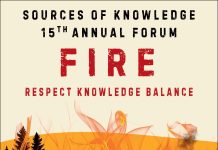By Tessa Swanton (Townson),
Bruce Peninsula Press
Residents, cottagers, and visitors of the Municipality of Northern Bruce Peninsula (MNBP) share a responsibility to stay informed about local fire restrictions during wildfire season. The 2025 season is recorded as one of the worst wildfire seasons on record with 5.5 million hectares burned across Canada, significantly impacting communities and air quality.
An August 18 interview with MNBP Fire Chief, Jack Burt, clarified some public questions regarding fire safety.
Fire Ratings
Multiple factors determine the fire rating including the Canadian Wildfire Index and Ministry of Natural Resources Mappings. The maps provide daily accurate looks at predictive modeling based on accumulated weather data. The Fire Chief also reviews current and extended weather forecasts over a two-week period and considers available provincial resources. The Fire Chief said, “a number of firefighters out of the Haliburton station are actioning fires out of Northern Ontario, Saskatchewan, Alberta, and Kawartha Lakes – as resources get depleted that’s another factor that we consider with our ratings.”
MNBP is fortunate to have green grass, rain and heavy snow load this past winter, which has kept conditions in the moderate to high range. The current fire rating is moderate, as of the printing of this newspaper (August 26). Rainfall on August 19 and some minimal rain forecasted in the upcoming weeks resulted in the rating being lowered from high to moderate on the morning of August 20.
Wildfire Risk
On August 18, Burt noted that some small wildfires were occurring in the Sudbury/Parry Sound area with the most significant wildfire close to MNBP happening in Kawartha Lakes. All three Kawartha Lakes wildfires were declared fully extinguished as of August 20 according to Ontario’s Forest Fire map. He said, “when you look at where they are, they have a different weather system that goes through there, they don’t have lakes on all three sides, we have some more humidity in our area, almost like a humidity bubble that covers the Bruce Peninsula.” Less humidity and drier conditions that increase wildfire risk are observed further inland to the east. Currently, MNBP firefighters have not been asked to assist other communities in fighting their wildfires.
When asked how to prepare volunteer firefighters for a potential wildfire, Burt said the answer is simple: “training.” He includes wildland training as part of the extensive training regimen where they work on hose deployments, how to fight wildfires, and specialized wildfire pumps.
“Forest Fire” is rated #3 on MNBP’s Municipal Community Risk Profile within the Forest Fire Emergency Plan. Burt advised that the past two annual emergency management exercises undertaken by municipal staff have revolved around a potential evacuation of the northern end of the Bruce Peninsula. “In the event that something does happen in the future then staff and our community partners are prepared for a potential evacuation.” He said, “the key is that people listen, evacuate, and follow directions – listen to radio station 104.3FM for directions and fire safety information. The more people that adhere to these warnings, the easier it is to extinguish a fire.”
The Fire Chief does not anticipate any wildfires transpiring in MNBP this year based on weather conditions – “we’re not seeing an increased fire risk even though the rating was high.” Although there is not a present hazard, MNBP firefighters train for handling wildfires so they are prepared “if” it happens.
Visit www.northbrucepeninsula.ca/emergencymanagement to read the 2024 Emergency Management Plans.
Campfires, Burn Permits, and Reporting Fires
Prohibiting campfires may occur if an extreme fire rating remains in effect for a prolonged period. An extreme rating signifies very dry conditions and fires could be imminent and spread rapidly. Burt stated that once an extreme rating is issued, implementation of a partial burn ban would initially be considered to limit open air burning, agricultural burns, and fireworks, while allowing campfires depending on conditions.
The two main causes of forest fires are lightning strikes and human negligence (most common) – not extinguishing a campfire or leaving a fire unattended.
If you witness a concerning fire, “don’t hesitate to call 911 anytime whether in an extreme or low rating.” The Fire Chief emphasized that burn permits are free and easily obtainable online at https://nbp.burnpermits.com/ Permits are required for campfires. Active permits notify the Fire Department of where fires are taking place.















